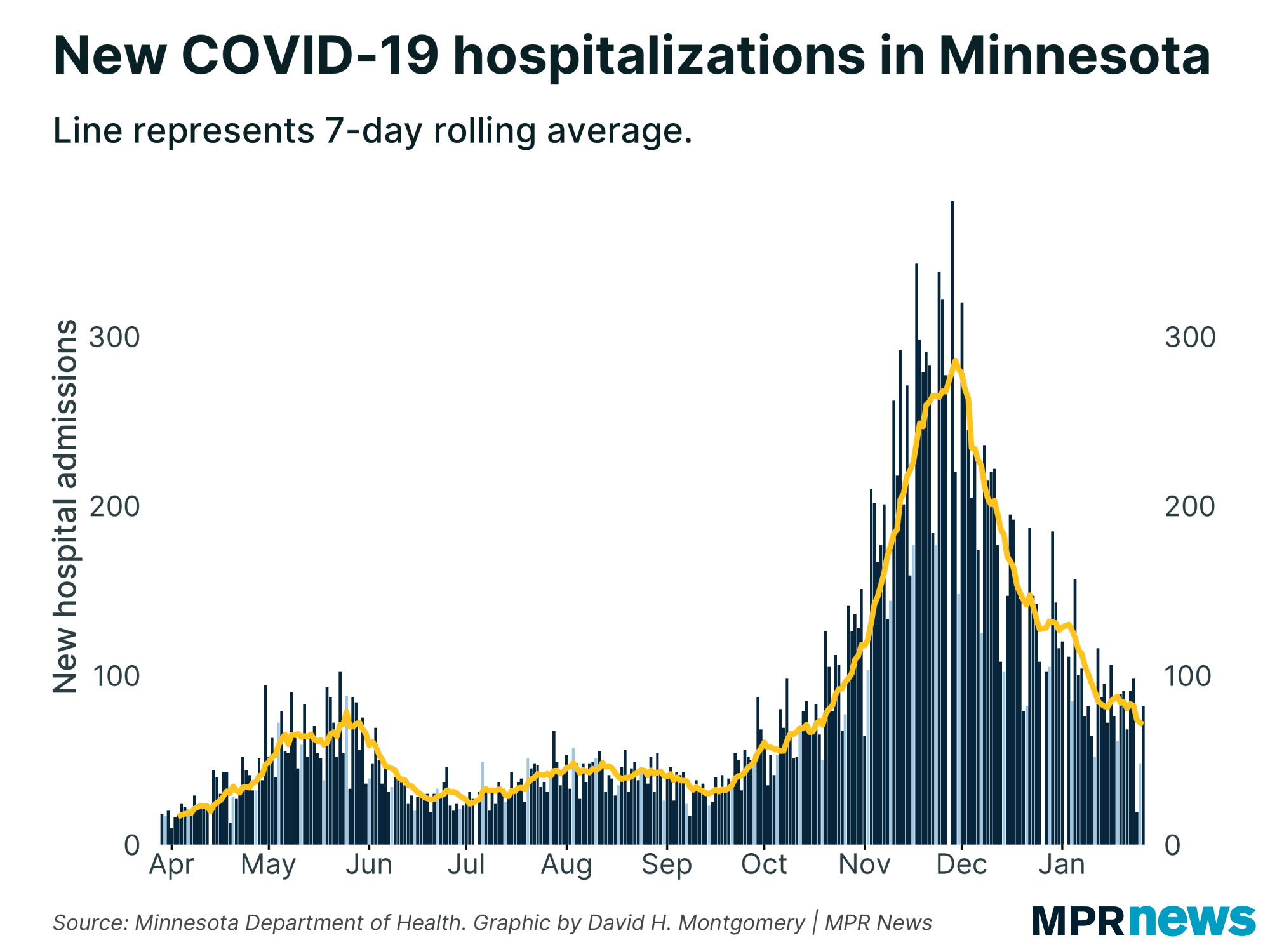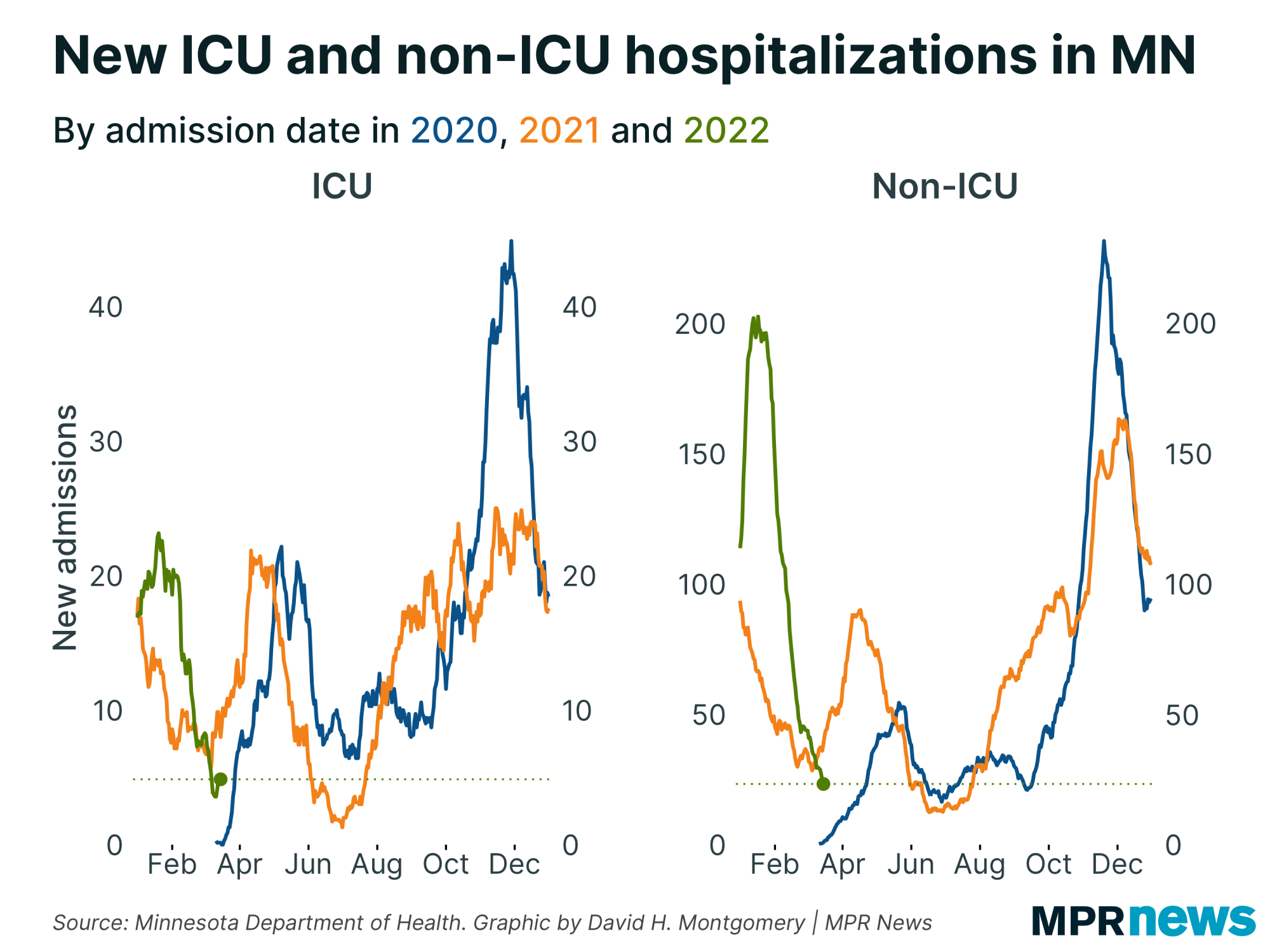Dec. 14 update on COVID-19 in MN: 18 deaths; new cases, hospitalizations easing

Go Deeper.
Create an account or log in to save stories.
Like this?
Thanks for liking this story! We have added it to a list of your favorite stories.
Updated: 2:46 p.m.
Minnesota’s newest COVID-19 report shows some hopeful signs following the toughest stretch so far in the pandemic.
New caseloads and hospitalizations continue to retreat from their recent highs, and there’s no sign yet of the anticipated surge from Thanksgiving holiday celebrations.
The Health Department on Monday recorded 18 more deaths, the lowest daily toll so far in an awful December where 869 deaths have been reported in the first 14 days.

New hospitalization admissions remain relatively high but far lower than their pandemic peak from two weeks ago. Nearly 1,400 Minnesotans are in the hospital with COVID-19, with more than 300 needing intensive care.
Turn Up Your Support
MPR News helps you turn down the noise and build shared understanding. Turn up your support for this public resource and keep trusted journalism accessible to all.

Health Commissioner Jan Malcolm told reporters that the decreasing demand for beds for COVID-19 patients was an encouraging sign and an “extremely important welcome bit of respite” for hospitals and care workers.
At the same time, she warned conditions were still volatile. “Clearly, we are still in a very precarious state. We’re certainly not out of the woods,” she said.
While down from its peak, the rate of new cases is still extremely high. “We just need to keep watching the data very closely to make sure that the decrease in cases is not simply an artifact of less testing.”
The deaths reported Monday raised Minnesota’s COVID-19 toll to 4,462. Among those who’ve died, about two-thirds had been living in long-term care or assisted living facilities; most had underlying health problems.

The 3,026 newly confirmed or probable cases reported out on Monday put Minnesota’s pandemic total at 381,841 to date. In about 91 percent of those cases, people have recovered to the point they no longer need to be isolated.

Vaccine shipments begin arriving in Minnesota
The newest numbers also come on the same day vaccine supplies began arriving in selected hospitals around the state — a bright spot in what’s been a bleak month.
On Monday, Olmsted Medical Center in Rochester said it received a shipment of about 975 doses of Pfizer’s vaccine. The Twin Cities veterans hospital also confirmed receiving a supply.
North Memorial Health Hospital in the Twin Cities and Sanford Bemidji Medical Center are also receiving supplies. The next shipments are expected to arrive in Rochester and other locations throughout the state on Tuesday.
Vaccinations are expected to begin next week, said Kris Ehresmann, the state’s infectious disease director. Minnesota is still expected to receive 183,000 doses of COVID-19 vaccines by the end of the month, she added.
Ehresmann and Malcolm continued to urge Minnesotans to do all they can — wearing masks in public gathering spaces, socially distancing and staying home if you don’t feel well — to guard against the spread of the disease. They emphasized that the pandemic is not over yet.
Caseloads spread across age groups
People in their 20s still make up the age bracket with the state’s largest number of confirmed cases — more than 74,000 since the pandemic began, including nearly 40,000 among people ages 20 to 24.

The number of high school-age children confirmed with the disease has also grown, with nearly 30,000 total cases among children ages 15 to 19 since the pandemic began.
Although less likely to feel the worst effects of the disease and end up hospitalized, experts worry youth and young adults will spread it to grandparents and other vulnerable populations.
It’s especially concerning because people can have the coronavirus and spread COVID-19 when they don’t have symptoms.
New cases ebb in rural Minnesota
Central and western Minnesota drove much of the increase in new cases over the past five weeks, while Hennepin and Ramsey counties showed some of the slowest case growth in the state.

After a spike in confirmed cases through much of November, all regions of the state have seen new case numbers plateau or start to fall.
Hot spots continue to pop up in rural counties relative to their population.

New caseloads still heaviest among people of color
In Minnesota and across the country, COVID-19 has hit communities of color disproportionately hard in both cases and deaths. That’s been especially true for Minnesotans of Hispanic descent for much of the pandemic.
Even as new case counts ease from their peak a few weeks ago, the data shows people of color continue to be hit hardest.

Distrust of the government, together with deeply rooted health and economic disparities, have hampered efforts to boost testing among communities of color, officials say, especially among unauthorized immigrants who fear their personal information may be used to deport them.
Similar trends have been seen among Minnesota’s Indigenous residents. Counts among Indigenous people jumped in October relative to population.
Officials continue to plead with Minnesotans to wear masks in public gathering spaces, socially distance, stay home if they don’t feel well and otherwise stay vigilant against the spread of COVID-19.
No sign yet of Thanksgiving celebrations surge
Officials have been anticipating another wave of climbing caseloads and hospitalizations soon originating from Thanksgiving holiday celebrations. But it hasn’t happened yet.
State public health leaders last week said they were somewhat hopeful that many families heeded the public pleas to not gather in big groups for Thanksgiving, and so the worst-case scenarios of a post-holiday surge might not materialize.

But they also cautioned that it was too soon to say a Thanksgiving celebration surge would not happen.
Even without a surge, Malcolm told reporters Friday that those numbers remain at alarmingly high levels.
“We are very grateful that the increases have slowed and come down a bit. (But) it boggles my mind, really, to think that 3,000 cases in a day feels like a good number to us,” she said. “This is still an extremely high rate of virus in the communities.”
Developments around the state
State suspends liquor license for bar that continued in-person service
The Minnesota Department of Public Safety on Sunday suspended the liquor license of an East Grand Forks, Minn., bar that had been operating in violation of state COVID-19 restrictions.
The Boardwalk Bar and Grill reopened to in-person service last week. Owner Jane Moss said her business would go under if she could not serve patrons in person.
The 60-day liquor license suspension announced Sunday is set to expire in February; another violation could result in a five-year license revocation.
The action follows a temporary restraining order issued Friday by a Polk County District Court judge, ordering the bar to close to in-person service.
Minnesota’s monthlong shutdown of in-person bar and restaurant service, along with youth sports and other activities, is set to expire at 11:59 p.m. Friday. Gov. Tim Walz has not yet said whether he'll extend the restrictions.
Representatives of a group called the Reopen Minnesota Coalition told KARE-TV on Friday that dozens of businesses plan to defy the governor's order in the coming week.
— MPR News staff
Top headlines
First doses of COVID-19 vaccine land in Minnesota: Days after the FDA approved the first COVID-19 vaccine for emergency use, doses of the Pfizer shot have arrived in Minnesota. The state expected 183,000 doses by the end of the month.
Minnesota Capitol stirs with electors, COVID-19 relief plan: Minnesota’s Electoral College members meet to send the state’s 10 votes Joe Biden’s way. Later, state lawmakers convene to vote on an aid package tied to COVID-19 fallout.
How one restauranteur is managing 2020: Many bars and restaurants are struggling to stay in business amidst the pandemic and Minnesota’s latest clamp down on the hospitality industry is making it even more difficult for them. The owner of a usually thriving Woodbury restaurant says they’re looking for help.
College students weigh the risks of holiday travel: Spikes in COVID-19 cases and statewide restrictions on gatherings mean what used to be typical trips home need to be considered carefully.
COVID-19 in Minnesota
Data in these graphs are based on the Minnesota Department of Health's cumulative totals released at 11 a.m. daily. You can find more detailed statistics on COVID-19 at the Health Department website.


